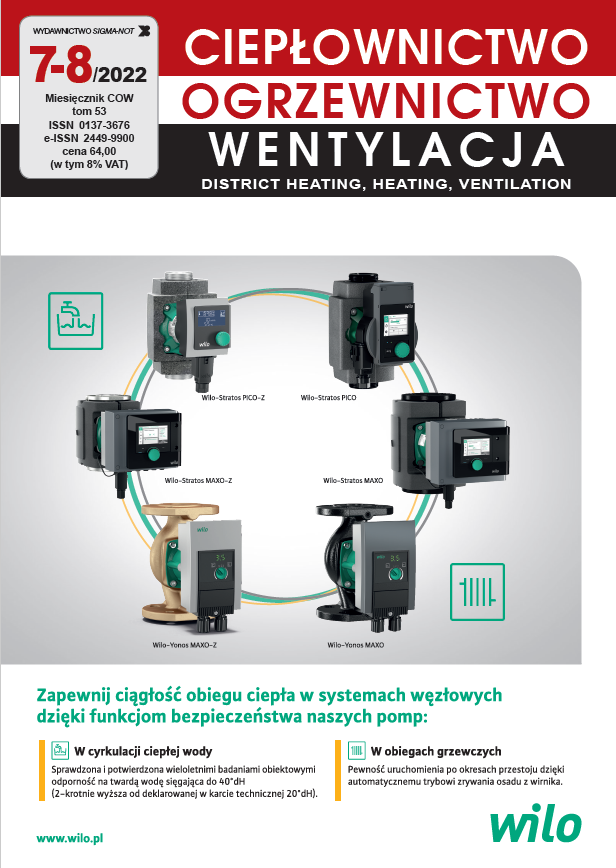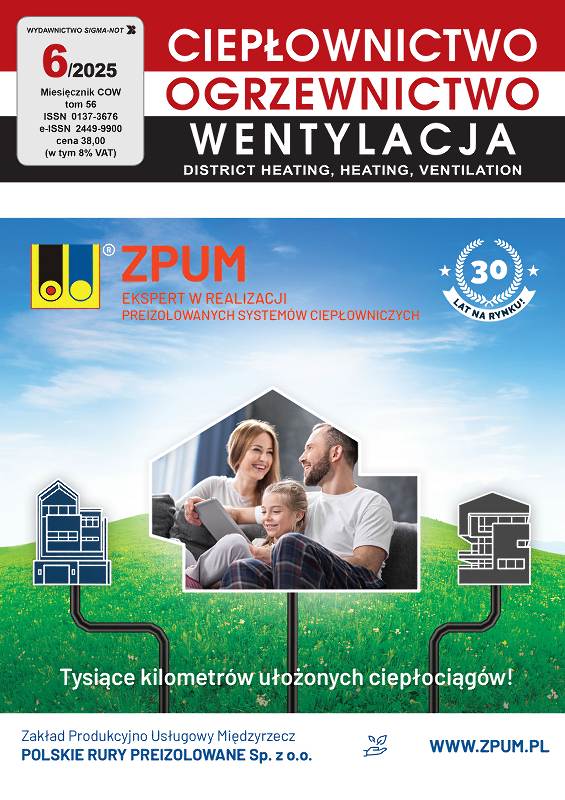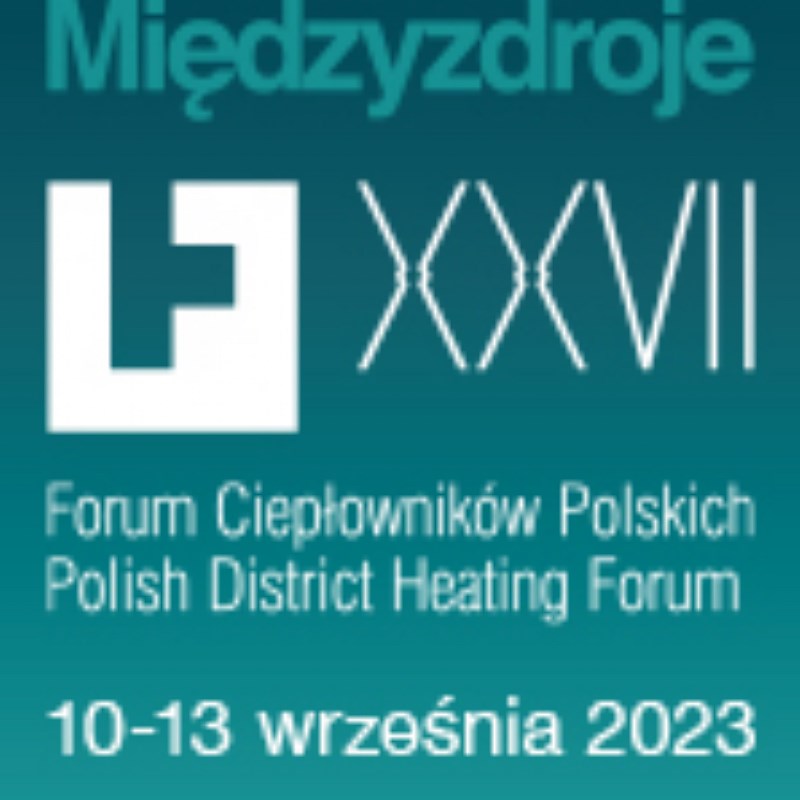HEATING, DISCTRIC-HEATING
➔ Władysław Szymański, Bożena Babiarz: Influence of Thermal Inertia of The Building on the Heat Load Diagram
DOI: 10.15199/9.2022.7-8.1
Keywords: heat load, thermal inertia, temperature variability
Abstract
A specific feature of district heating systems is the fact that the heat load of the system is highly variable through the year. The heat load diagram is used to analyze this variability with multiple applications. The basis for the preparation of the load diagram is the variability of the outside air temperature, characteristic for the location of the object for which the diagram is prepared. The methodology of drawing up the diagram assumes that the heat loss for heating and ventilation is proportional to
the temperature difference between internal and external air at any time, ignoring the thermal inertia of building partitions.
In the presented article, an analysis of the influence of thermal inertia of partitions on the thermal loads’ variability during a year was carried out, in comparison with the load diagram used so far. The calculation methodology developed earlier was used to determine the thermal inertia. As a result, a significant difference was demonstrated between the theoretical and real course of the thermal load diagram. The results were confirmed by examples of changes in heat consumption in real buildings.
➔ Leszek Konopka: Comparative Analysis of Trigeneration Systems Working for a Hospital Facility. Part I
DOI: 10.15199/9.2022.7-8.2
Keywords: absorption chillers, combined Heat and Power, trigeneration, energy efficiency
Abstract
Increasingly higher requirements of energy efficiency of devices and installations make it necessary to use solutions aimed at minimizing energy consumption and reducing environmental pollution in the form of emissions of harmful substances or waste resulting from the process of burning solid fuels. The answer to such needs are modern solutions based on high-efficiency devices, as well as solutions that allow the use of waste heat. And all this is used in order to protect the environment and at the same time use energy and heat power in the most efficient way. Therefore, the improvement of energy efficiency use and energy production is needed as well as promotion of renewable energy use leading to reduce the consumption of traditional energy carriers. In this thesis an assessment of the absorption chiller performance is presented. The paper presents an overview of combined heating, cooling and power sources (called trigeneration or CHCP) considering the impact of changing the source of cold on the operation of the entire system. The analysis was carried out on the basis of own studies on the change of the entire system from an absorption chiller to a compressor chiller. The impact of this change on the operation of the entire system and the investment and operating costs incurred were also analyzed. The analysis of the benefits associated with the possibility of producing cold by an absorption chiller operating for the air conditioning needs of a hospital building was also carried out.
➔ Tomasz Cholewa, Alicja Siuta-Olcha: for Heat as a Method of Forecast Control of the Heating System in Building. Part 2: System Operation and Energy Savings
DOI: 10.15199/9.2022.7-8.3
Keywords: forecast control, forecasting heat consumption, building energy model, control of heating, energy efficiency in existing buildings, smart buildings
Abstract
One of the possibilities to increase the energy efficiency of heating systems in existing buildings is the use of forecast control. However, there is still no simple and easy-to-apply method for forecasting control taking into account internal (user influence) and external (weather conditions) factors. Therefore, this article presents the second part of information on the method of forecast control of heating systems, which is easy to apply in existing buildings. In particular, the method of taking into account the preferences of users in the form of an equivalent indoor temperature and the method of implementation of forecast control in the building were presented. It was found that the use of forecast control of heating system may allow for energy savings at the level of over 10% (without reducing thermal comfort in heated rooms), which, with the simple payback time (about 1 heating season), makes this solution one of the basic methods for increasing energy efficiency in existing and new buildings.
➔ Małgorzata Niestępska: Application of Econometric Models in The Process of Digital Transformation of Heat Supplies
DOI: 10.15199/9.2022.7-8.4
Keywords: econometric modeling, heating, digitization, energy, process control
Abstract
The vision of implementing the next stage of green transformation
in the form of the negotiated package “fit for 55” raises
concerns of representatives of the energy and heating industry in
Poland. These concerns are mainly related to the scale of investment
challenges and the costs already incurred under the CO2
emission allowance trading system, i.e. the EU ETS. Russia’s
invasion of Ukraine has revised the current directions of the
policy pursued as part of the transformation that is being carried
out to switch from fossil fuels to renewable energy sources, with
the priority of gas as a transitional fuel. Efficiency has again
become the most important factor of transformation, which is
significantly supported by the digitization of energy management
at every level. Starting from minimizing the use of primary
energy at the generation stage, through transmission and final
consumption. Efficiency thanks to the use of digital tools of process
decision optimization models, which also aim at economic
optimization, should reduce energy costs throughout the entire
life chain. The article presents examples of the implementation
of econometric models for programming network operation,
which, supplemented with elements of artificial intelligence using
an updated database, can be used in various spheres of process
and business decision-making. Digital analysis and an early
warning system using this analysis improves the work efficiency
and communication of the systems. Heating companies, largely
responsible for the success of “fit for 55”, now have a lot of data
measured in the processes of energy production and supply, but
they do not always fully use these resources. Meanwhile, effective
digitization, aimed at reducing energy consumption, does
not mean the measurement and recording itself, but the purposeful
analysis of the data set for modeling the process and formulating
recommendations for the right decision.
➔ Mariusz Piękoś, Piotr Natkaniec, Paweł Jastrzębski: Application of Turbine Pressure Stabilization Systems in Island Power Supply Systems of District Heating Object at MPEC S.A. in Krakow
DOI: 10.15199/9.2022.7-8.5
Keywords: turbine plants, dispatch pressure, district heating network
Abstract
This paper describes the way of development of turbine installations
used to stabilise the disposable pressure in the district
heating network belonging to Municipal Thermal Energy Enterprise
S.A. (MPEC S.A.) in Krakow with the simultaneous use of
recovered and transformed electrical energy in network facilities.
Through the presentation of methods for the recovery of mechanical
energy of the heating medium and examples of the use of turbine
installations in district heating networks, a potential solution
to the problems of the district heating company associated with an
excess of disposable pressure in networks and the effects of work
carried out to date in Krakow were shown. Conclusions from the
test installations carried out to date and a system operating under
actual operating conditions in a district heating chamber show the
operating methodology and the real benefits of turbine installations
for the control of dispatching pressure.
➔ GeoGrid DH – gotowe rozwiązanie GIS usprawniające zarządzanie siecią ciepłowniczą w mniejszych przedsiębiorstwach
Abstract
Jeżeli w swojej pracy potrzebujesz aktualnych informacji
o przebiegu sieci ciepłowniczej, przygotowujesz
system ciepłowniczy do sezonu grzewczego, chcesz podejmować
decyzje o rozwoju sieci na bazie kompletnych
i wiarygodnych informacjach o jej stanie oraz zapotrzebowaniu
na ciepło, poznaj GeoGrid DH. To stworzone
przez Globemę rozwiązanie GIS-owe, oparte na uniwersalnym
systemie informacji geograficznej, do zarządzania
siecią ciepłowniczą.
VENTILATION, AIR-CONDITIONING
➔ Katarzyna Lisik, Robert Cichowicz: Microclimate in the Pool Hall
DOI: 10.15199/9.2022.7-8.6
Keywords: microclimate, microorganisms, air pollution
Abstract
In todays world, especially recently in the era of a pandemic,
people are increasingly both looking for and using active forms/
modes of life to spend their so-called „free time”. Recently, not
only among children and adolescents, but also among adults, it
can be noticed that sports activity has become a priority. One
of the most frequently chosen sports activities is swimming
(both recreational and sports), which can now be carried out
in many larger or smaller indoor swimming pools. As a result,
more and more people stay in rooms/buildings with a specific
microclimate, favoring the emergence/development of various
types of microbial infections (in particular, various types of
mycoses). To prevent this, in such facilities as indoor swimming
pools, it is very important to correctly select mechanical
ventilation, which would take into account numerous external
and internal parameters of the room. As a consequence, the
task of pool ventilation is to maintain a proper microclimate
inside the pool hall. At the same time, it should be remembered
that unfavorable temperature and humidity conditions may
contribute to the discomfort of pool users, but also to the development
of various types of microorganisms. What is more,
moisture and fungus may have a negative effect on the building
structure and contribute to the destruction of building partitions,
and the physical and biological corrosion of building
elements may threaten the safe use of the facility. Therefore,
in order to check the scale of these phenomena, it was decided
to analyze the microclimatic and microbiological conditions in
the large building of the swimming pool hall (in the building
of the Academic Sports and Didactic Center „Zatoka Sportu”
in Łódź). Thanks to this, information was obtained about the
temperature range, relative humidity, air flow velocity and the
number of microorganisms present in the air in the swimming
pool hall both in time (with low load on the sports facility and
during the greatest load on the facility, i.e. when the greatest
sports activity was carried out in it), as well as depending on
the location and distance/height from the pool basin. It seems
that performing this type of measurements may be helpful, and
maybe even necessary, to pay attention to the importance of
the correct selection, design and use of mechanical ventilation
in this type of facility.










